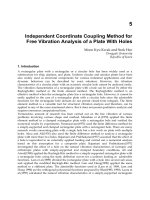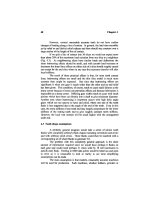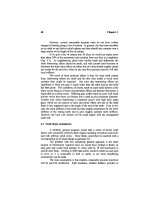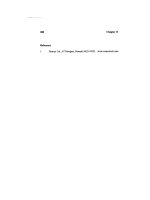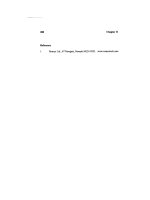Machine vibration standards part 4 comparative historical
Bạn đang xem bản rút gọn của tài liệu. Xem và tải ngay bản đầy đủ của tài liệu tại đây (8.41 MB, 25 trang )
Part 4 – Comparative & Historical Standards
Barry T. Cease
Cease Industrial Consulting
September 9th, 2011
1) ABSOLUTE, GENERAL (OK)
2) ABSOLUTE, MACHINE SPECIFIC (GOOD)
3) COMPARATIVE (BETTER)
4) HISTORICAL (BEST)
Cease Industrial Consulting
Machine Vibration Standards: Ok, Good, Better & Best
2
•
•
1)
2)
3)
4)
5)
Both comparative & historical vibration standards differ from absolute standards in that they
don’t begin with assumptions of what a machine’s vibration levels should be. They instead
essentially let either the history from a group of similar machines or an individual machine’s
history “decide” what the levels should be.
Comparative vibration standards involve the following:
How one machine’s vibration levels at a specific measurement point compare to that at a very
similar machine (families of machines).
How the vibration level
Statistical standards can be applied in at least two different ways:
Using the history from a specific measurement point on an individual machine.
Using the combined histories from specific measurement points from similar machines.
•
The current vibration level is compared to either a multiple of the baseline level (usually 50-100%
of baseline) or the average level plus a multiple of standard deviations from that average (usually
1, 2 or 3 standard deviations).
•
If both no machine history and no similar machines are available for comparison, one can begin
with baseline levels and observe for changes (usually 50-100%) from them.
•
Statistical standards generated from historical data become more and more meaningful when
either longer histories or a greater number of similar machines are used.
Cease Industrial Consulting
Machine Vibration Standards: Ok, Good, Better & Best
3
PROS:
a) Can be applied immediately if either a baseline approach is taken or if a
number of similar machines exist in the plant.
b) Accounts for most (similar machines) if not all (individual machine
history) of the unique characteristics that determine a machine’s final
vibration level such as machine type, mounting, speed, loading, etc.
c) Gives a unique perspective to determining the severity of similar
problems on different machines. Quite often makes the job of picking
which of the bad machines to work on during the upcoming outage more
easy than it would be otherwise.
d) Once substantial historical data are acquired from either an individual
machine or a group of similar machines, these standards become quite
powerful in detecting problems.
CONS: If using calculated average + standard deviation values, either a
large amount of historical data from an individual machine or a good
number of similar machinery in the plant are required to generate
meaningful standards.
Cease Industrial Consulting
Machine Vibration Standards: Ok, Good, Better & Best
4
•
•
1)
2)
3)
4)
5)
6)
Historical or Baseline data from the exact machine & point in question (BEST)
Historical data from the exact machine & measurement point in question will almost always be
superior to all other types of standards or specifications. This is because it takes into account all
the pertinent factors effecting machine vibration such as:
The specific dynamic forces present
The specific machine’s & base’s combination of mass, stiffness & damping
Loading
Speed
Unique process conditions
Transmission of vibration from nearby machinery
•
PROS: a) Provided enough historical data exists, this technique arguably provides the most
accurate indication of changing machine conditions as it is based specifically on the machine in
question with all its unique characteristics.
•
CONS: a) Requires historical data on the machine in question to be effective, and the more
historical data available, the more meaningful the technique becomes, b) If a machine begins its
service with problems, there is a chance these problems could be overlooked for some time as this
technique by definition watches for changes from the long-term historical trend (perspective can’t see the forest for the trees,etc).
Cease Industrial Consulting
Machine Vibration Standards: Ok, Good, Better & Best
5
1)
2)
3)
4)
5)
6)
7)
8)
9)
10)
11)
Below is a list of common vibration parameters used by the author to determine a machine’s condition.
Not all parameters are created equal. Each has their own strength’s & weaknesses. The best
parameter is the one most sensitive to the problem’s you experience most often on your machine.
Overall levels (ips-pk, ips-rms, etc)
Waveform levels (g’s-pk, g’s-pk-pk, etc)
1x RPM levels
2x RPM levels
Subsynchronous levels (below 1x rpm)
Electrical frequency levels (ie: LF, 2x LF or 6x LF, etc)
Vanepass levels and multiples thereof
Gearmesh levels and multiples thereof
Bearing fault frequencies or band levels
High frequency energy bands such as HFD, Spike Energy, etc
Levels from acceleration enveloped or “Peakvue” data.
Meaningful parameters should be chosen based on the forcing frequencies generated by the unique
machine in question.
All the examples of parameters mentioned above are valid for particular machinery, but the first three
parameters underlined and in bold above are in the opinion of the author the three most important to
be monitored for nearly all machinery.
Cease Industrial Consulting
Machine Vibration Standards: Ok, Good, Better & Best
6
A normal distribution curve or histogram as
shown at right represents the theoretical
limits your historical data should fit within if
no significant problems exist.
The more historical data used to calculate the
average & standard deviation, the more
meaningful these limits become.
Your chance of achieving anything like a
normal distribution curve from your
historical vibration data improves if done on
the same machine, same measurement point
as opposed to similar machines.
In general, those data that don’t fit within 2 or
3 SD from the average increasingly indicate
that either a problem exists or that they are
“outliers” (bad data). In either case, they
should be further investigated.
These calculations of average values &
standard deviations, etc can be made either
by the vibration database software itself or by
a spreadsheet software such as Excel once the
data is exported.
Cease Industrial Consulting
Machine Vibration Standards: Ok, Good, Better & Best
7
•
1)
2)
3)
4)
5)
6)
•
•
Real historical vibration data will many times not conform perfectly to this
normal distribution curve due to factors such as:
Changes in the process such as load, pressure, speed, etc.
Different personnel collecting vibration data.
Different transducer used.
Different transducer mounting used.
Differences in surface quality that transducer is mounted on (dirty, not
level, etc).
Changes in the amount of vibration transmitted from nearby machines.
To the degree to which these factors and others not mentioned can be
controlled, your historical vibration data should conform better to the
normal distribution curve.
It is thought by the author that much can be learned going forward by the
study of histograms of historical vibration data.
Cease Industrial Consulting
Machine Vibration Standards: Ok, Good, Better & Best
8
Tight Grouping
Cease Industrial Consulting
Not So Tight Grouping
Machine Vibration Standards: Ok, Good, Better & Best
9
Cease Industrial Consulting
Machine Vibration Standards: Ok, Good, Better & Best
10
Cease Industrial Consulting
Machine Vibration Standards: Ok, Good, Better & Best
11
Machine Vibration Standards: Ok, Good,
Cease Industrial Consulting Better & Best
12
Data collected by the same person during every survey.
Mark exact points where data is to be collected everytime.
Use the same transducer & analyzer during every survey.
Wait 2 to 3 seconds or more after placing sensor in position before collecting
data .
As much as possible, try to collect data when the load, speed, and other
conditions are identical.
As much as possible, collect data from a clean, flat surface.
Collect more data and/or identify similar machines to bring into the
calculations.
Identify outliers quickly (in the field if possible) to determine whether they
represent simply bad data (discarded or new data collected) or a significant
change in the machine’s condition that should be flagged.
Cease Industrial Consulting
Machine Vibration Standards: Ok, Good, Better & Best
13
Given the long
historical trend data
available, it wasn’t hard to
see that something big
was happening here!
•
In this example, 14-ea
historical data points from
an individual machine
and an individual
measurement point were
used to calculate the
average & standard
deviation values applied.
•
Either the AVG+2SD or
the AVG+3SD alarms
worked well in this case.
•
Cease Industrial Consulting
Machine Vibration Standards: Ok, Good, Better & Best
14
Cease Industrial Consulting
Machine Vibration Standards: Ok, Good, Better & Best
15
Cease Industrial Consulting
Machine Vibration Standards: Ok, Good, Better & Best
16
Cease Industrial Consulting
Machine Vibration Standards: Ok, Good, Better & Best
17
• In the example at right,
statistical standards were
calculated from very similar
motors & identical measurement
points.
• Each column represents the
waveform level in g’s-pk-pk
from a specific motor.
• The motors were of the same
size, speed, loading & operation.
• In this case, all those motors
violating the yellow ALERT
LEVEL of AVG+1SD were
observed to have bearing faults
of differing severity and type in
the vibration spectral data.
Cease Industrial Consulting
Machine Vibration Standards: Ok, Good, Better & Best
18
Cease Industrial Consulting
Machine Vibration Standards: Ok, Good, Better & Best
19
• Each distinct color
represents a different
fan.
• Compare the
waveform level in g’spk-pk from each fan at
each measurement point
versus the others.
• This simple way of
relating similar machines
to one another often
makes it easy to both see
which machine has the
problem(s) and when
more than one machine
is found to have
problems, which one
likely has the more
severe problem.
Cease Industrial Consulting
BEFORE
REPAIRS
Looseness &
bearing faults
at this fan
Bearing fault
at this motor
Machine Vibration Standards: Ok, Good, Better & Best
20
AFTER
REPAIRS
Note how after
repairs, the levels
agree much better
between similar fans
from point to point
(better grouping).
Fan bearings changed
Motor changed
Cease Industrial Consulting
Machine Vibration Standards: Ok, Good, Better & Best
21
BEFORE
REPAIRS
Cease Industrial Consulting
Machine Vibration Standards: Ok, Good, Better & Best
22
AFTER
REPAIRS
Machine Vibration Standards: Ok, Good,
Cease Industrial Consulting Better & Best
23
18)
Berry, Jim, Analysis 1 Manual – How To Implement An Effective
Condition Monitoring Program Using Vibration Analysis, 2nd Edition,
Chapter 7, Proven Method For Specifying Spectral Alarm Band Levels &
Frequencies Using Today’s Predictive Maintenance Software Systems,
Technical Associates Of Charlotte, PC, 1997
19)
Eshelman, Ron, Machinery Vibration Analysis 2, Machinery Condition
Analysis, p.332, VI Press, IL, 1996
20)
Blake, Randall, “Statistical Approach To Machinery Condition
Monitoring”, Mini-Course Notes, 1993 Vibration Institute Symposium
Cease Industrial Consulting
Machine Vibration Standards: Ok, Good, Better & Best
24
Machine Vibration Standards: Ok, Good,
Cease Industrial Consulting Better & Best
25



